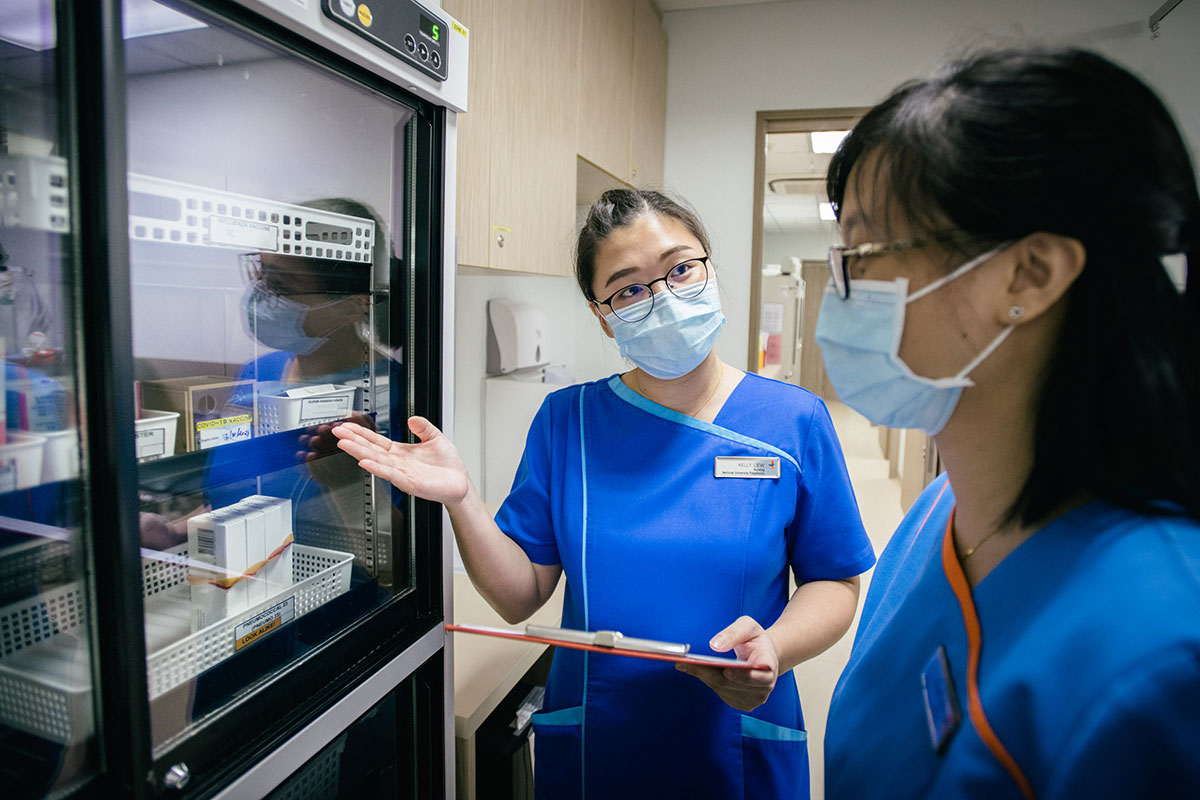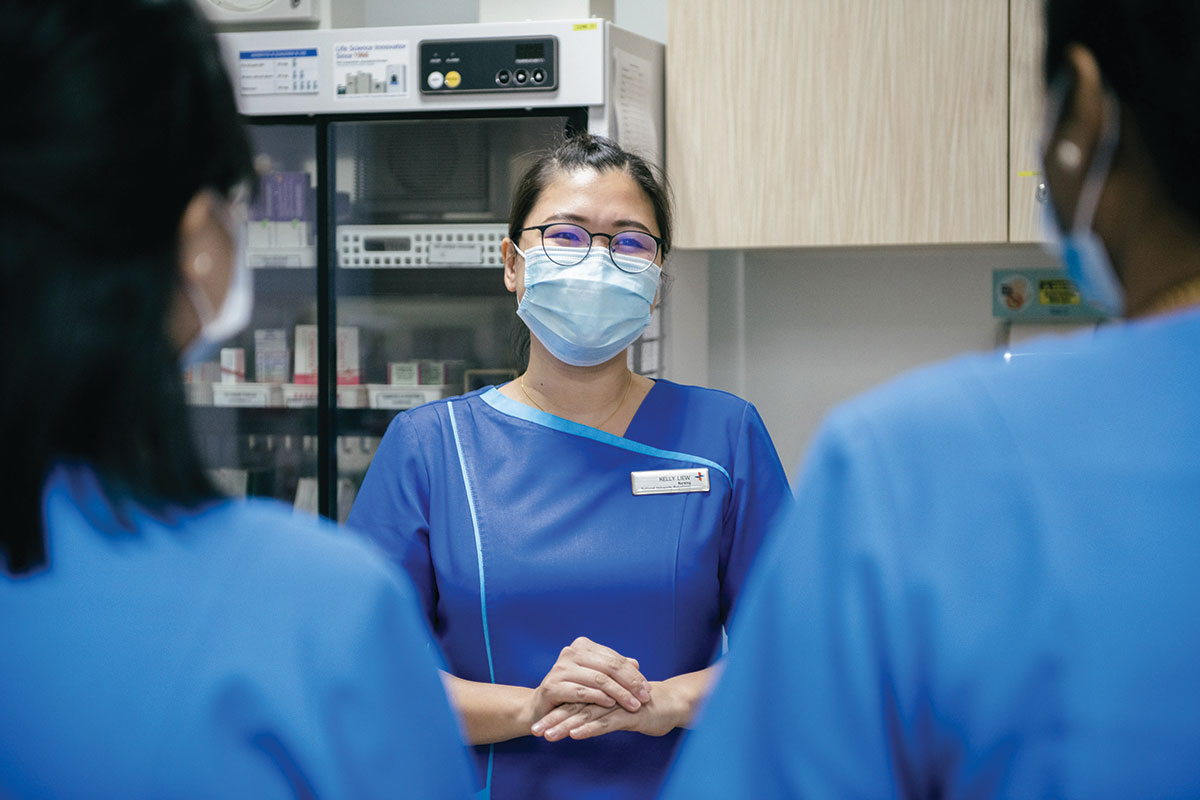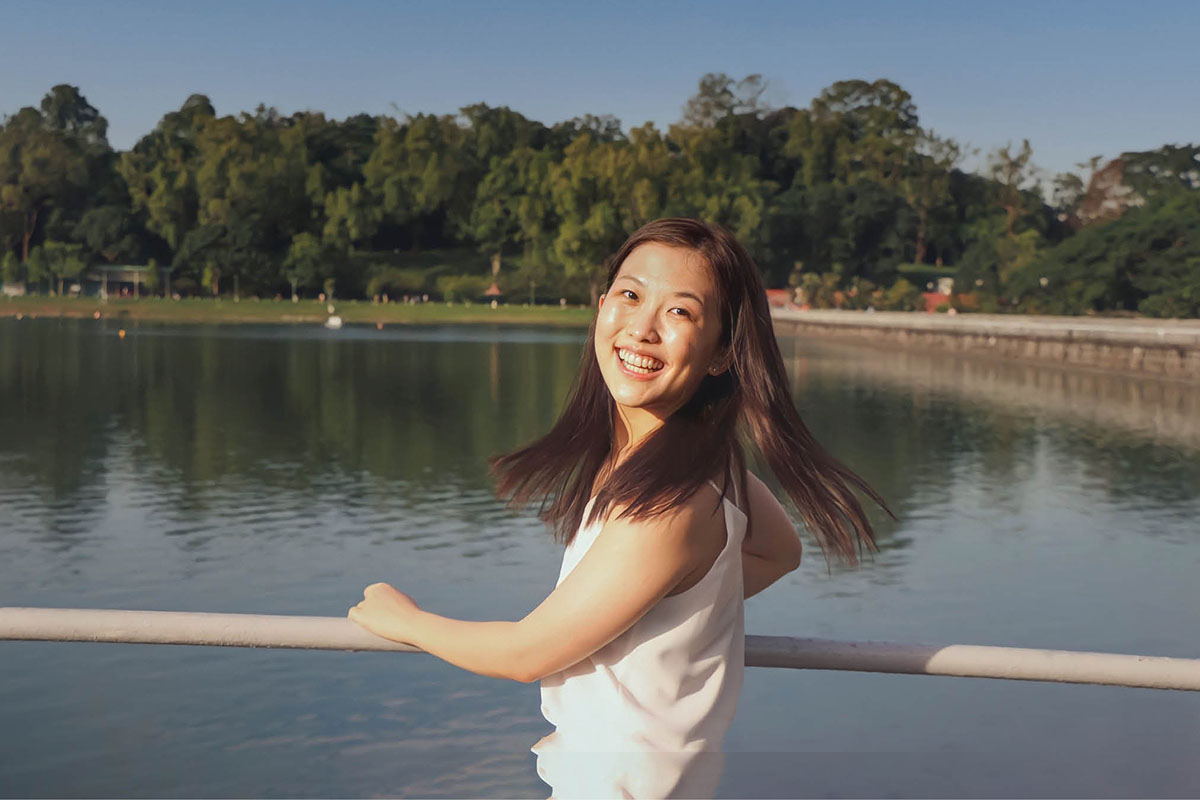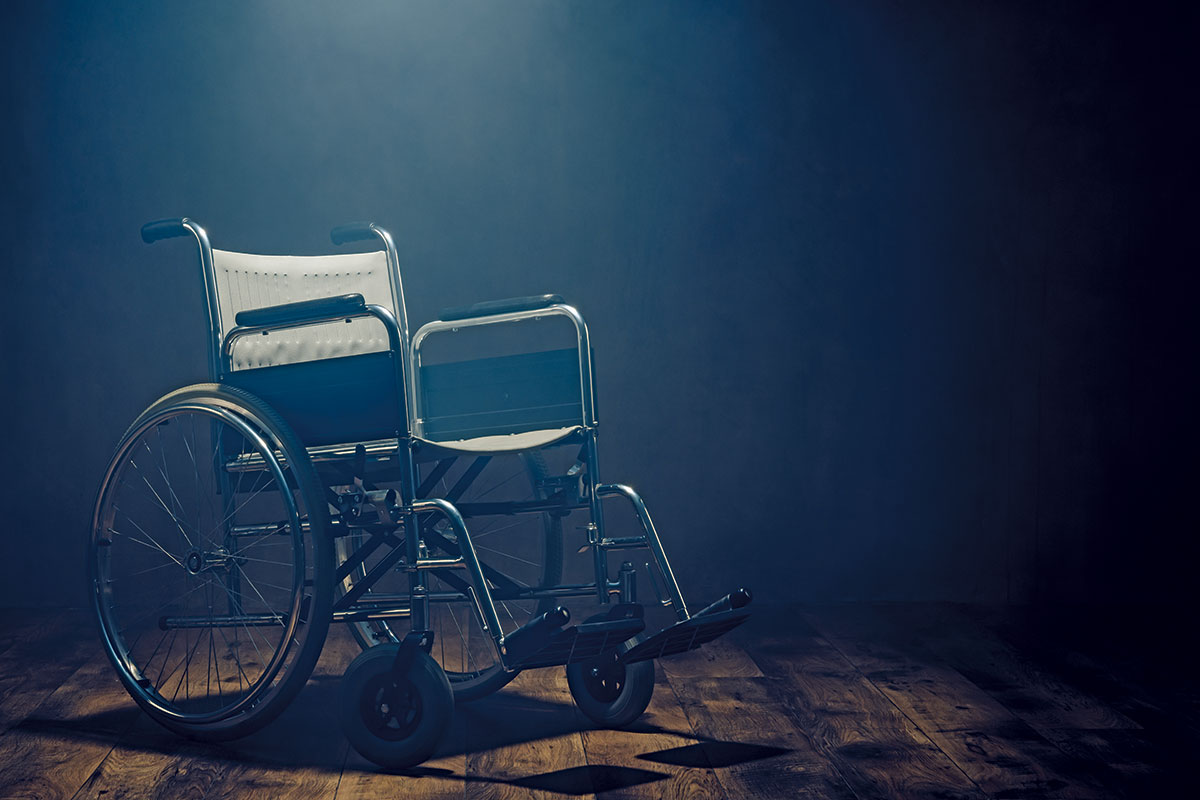
Issue 40 / November 2021
Nursing
A Vaxxing Situation

NUS Nursing alumna Kelly Liew shares her experience as a member of a vaccination operations team at the National University Polyclinics (NUP).
arly this year, the NUP was asked by the Ministry of Health (MOH) to set up a COVID-19 vaccination service. It came as a surprise as we already had a lot on our plate with dormitory support, manning Swab and Isolation facilities (SIF) as well as conducting COVID-19 swab tests for the public. These were responsibilities that came in addition to our usual work. Our initial reservations were assuaged when our NUP leadership reminded us that the Polyclinics were the best place to get the vaccination exercise going. The elderly tend to be our patients, relying on us for their chronic care needs, and there is a greater likelihood that they will choose to be vaccinated, if the shots are delivered by the team and in an environment they are familiar with.
Looking back, it amazes me how quickly eight months have passed since NUP joined the effort to help vaccinate the nation. When the news came at the National Day Rally that we had reached the ‘80%-vaccinated’ milestone, I was not only elated, but also very proud that we have come so far. A new agency nurse told me not too long ago that things would definitely go awry when the MOH announced that patients could walk into polyclinics without appointments. She was certain that this “major change” was going to affect staff morale and the management of vials. I reminded her that change is constant and we should be ever ready for anything that comes our way.

Kelly briefs her nurse on vaccine storage.
When we first started, we did not really know what we were dealing with. Everything came in a flash and information about the vaccines arrived fresh from the Health Sciences Authority. It was a constant struggle to deal with the short expiry date of the Pfizer-BioNtech vaccine. Every vial we received had to be used within the next three to four days! Often we feared wastage and had to rush the unused vials to another polyclinic to be used before expiry. The lead nurses, who were in charge of managing vial-ordering based on projected appointments, were often under a lot of stress as they had to bear the consequences of under or over-ordering for the week. We also had to be accustomed to a new IT system that was foreign to us, and provide support to the many agency staff employed solely for “VaccOps”, as we called it. I could even remember us doing trial runs on “pretend patients” to make sure everything was smooth for our first vaccine roll-out date at NUP.
Another challenge was the number of doses we could get from each vial. The first batch of syringes and needles only yielded five doses per vial and we were almost always competing with one another to see who could get the sixth dose. As much as we wanted to get that extra dose, we were also afraid that if we reported a sixth dose, we would be asked to do it again: it was something that we definitely did not have confidence to do then. Some of us Googled for solutions and I even suggested to friends in MOH to bring in Low Dead Volume (LDV) syringes and needles to help us squeeze more out of each vial. LDV syringes are designed to reduce the amount of vaccine remaining within the syringe and needle after an injection is completed. So when the first batch of LDV syringes arrived, we were extremely grateful as it almost always produced the desired dose number six. Shortly after, the second batch of consumables arrived and they were even better, making a seventh dose possible from each vial.
“As healthcare providers, staff knew the importance of not wasting the vaccines. They would be on the standby list as the last patients to ‘soak up’ the remaining doses for the day.”
Doses aside, there was also the uncertainty of the side effects of the vaccine. Initially, even the vaccinators were not convinced it would be safe for us as the reported side effects were just too scary. People who volunteered to go first were seen as putting themselves at risk, myself included. I believe in the importance of good leadership in this pandemic. Prime Minister Lee Hsien Loong himself took his first dose on 8 January 2021 and so did many members of our NUP senior leadership, and I felt that I needed to follow their example and take that leap of faith.
As more people got vaccinated, our staff gained more confidence and joined in too. We vaccinated healthcare staff first, followed by people who were working on the front lines, such as national servicemen. It was quite a sight to see the team from the Police K-9 unit in our polyclinic, all in their smart uniforms, though without their canine friends. Our staff also took it upon themselves to standby as “soakers” at the end of the day. As healthcare providers, staff knew the importance of not wasting the vaccines. They would be on the standby list as the last patients to “soak up” the remaining doses for the day. On days where no extra doses were available, staff were understanding and would continue to standby the next day. This display of understanding and team spirit by the entire clinic team was the key to success in ensuring zero wastage of vaccines in our clinics.

Kelly briefs the nurses before the start of their duties.
I must also applaud the nurses for never saying anything negative about the vaccine despite their reservations. They soldiered on and gave their best, with the knowledge available then. As more information about the vaccine became available, we opened up to more people, such as people with a history of allergies, pregnant women and even teenagers. So many things have changed since we first started and I cannot imagine what goes through the vaccinators’ minds as they deal with these changes every day. I often wondered why they did not complain.
Being on the ground and pulling through with gritted teeth, I wonder, how do our senior leaders deal with this? As they continue to receive first-hand information on the vaccine, they have to work together with the ground leads to come up with a proper workflow in a short period of time. It does not sound easy but it definitely makes me feel at ease knowing that we have their full support in what we do. This inspires me to not only go further but to also continue to encourage the nurses on the ground to fight on.
COVID-19 has changed us and will continue to do so. but being part of this national vaccination drive is such a surreal experience. As we embark on the next leg of our journey to provide booster doses to our seniors and immunocompromised patients, I am grateful that we are embracing these changes so well as they come. Most of all, I am grateful for all the doctors, nurses and screeners who stood by us through this tough journey. Who can say they were part of the team that helped vaccinate the nation? We can, because that’s exactly what we did!




